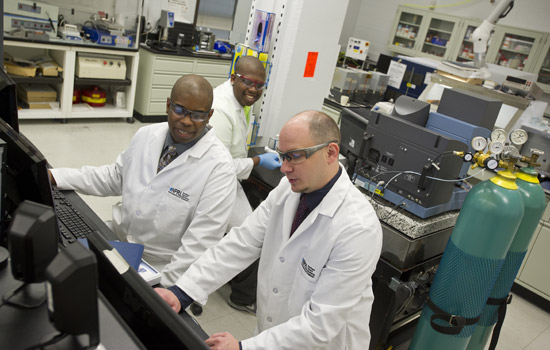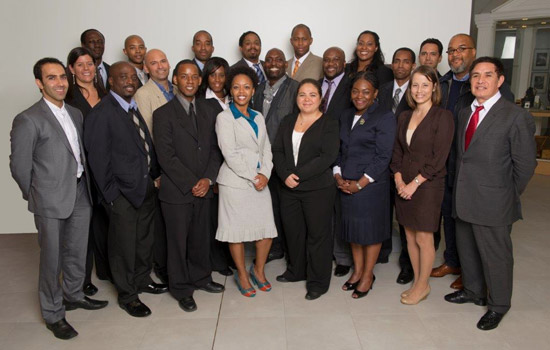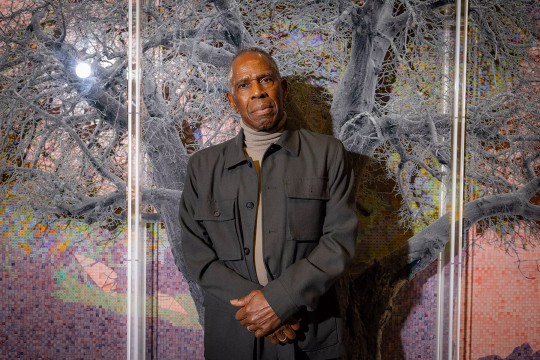RIT offers Future Faculty Career Exploration
Program is nationally recognized for its recruiting model showcasing potential career options
Provided
Some of the 2012 participants of the Future Faculty Career Exploration program gather after one of the workshops. The program, now in its 10th year, brings scholars near the end of their doctoral studies to RIT to explore career options.
One of the hiring myths in higher education is that there are too few qualified, diverse faculty candidates. Renee Baker has shattered that myth.
The executive director of the Office of Faculty Recruitment and Retention at Rochester Institute of Technology, Baker developed a comprehensive program with strategies to successfully recruit, hire and retain diverse faculty. The program, Future Faculty Career Exploration, brings in scholars from around the world who are nearing the end of their doctoral studies to RIT to explore potential career options. It has become a national model in higher education.
The 2013 Future Faculty Career Exploration event takes place Sept. 19-23 at the university, marking the 10th year of the program.
“The program was established to develop and sustain the pipeline necessary to recruit under-represented faculty,” says Baker. “There are qualified candidates out there. We’ve found a way to bring them to RIT, and these prospective candidates are able to learn more about navigating the entire hiring process.”
While on campus, these scholars will experience a unique opportunity to explore potential career choices through interactions with faculty, staff, students and senior leadership, Baker says. They also have an opportunity to present current research, participate in informational interviews with search committee chairs, and observe classes or guest lecture in RIT’s colleges.
Baker’s premise is that active recruiting and establishing relationships at peer universities and community networks reaps benefits for both the university and the individuals seeking teaching positions in higher education.
“Outstanding applicants often do not apply for advertised positions, but may do so if personally contacted,” says Baker, who is a regular participant at the Compact for Faculty Diversity’s Institute for Teaching and Mentoring conference, an annual event that brings together nearly 1,200 doctoral scholars and prospective university employers. It is just one of her resources in building a pool of potential faculty candidates for RIT.
In the program’s 10 years, Baker and her staff have processed nearly 1,800 applications, sponsored 247 participant-visits, and supported more than 600 faculty search committees. Of the latter, the university made 30 offers resulting in 11 tenure-track and 5 non-tenure track hires. From 2004-2012, 19 percent of the African American, Latino American and Native American tenure track hires represented STEM disciplines—science, technology, engineering and mathematics—as well as behavioral sciences, humanities and fine arts.
“If institutions really want to hire and retain faculty of color, they must move beyond merely debunking the myths. A diverse faculty can bring innovative kinds of scholarship to an institution, educate all students on issues of growing importance to society and offer links to communities not often connected to our campuses,” says Baker. She references RIT’s Native American Future Stewards program as an example of this. The program has recruited students from 22 nations. The concept for such a program began with the recruitment and hiring of the two Native American faculty. Since forming the Future Stewards Program, RIT has consistently been listed in the Winds of Change college guide among the best colleges in the nation for Native Americans.
 Reginald Rogers, center, a recent tenure-tract faculty hire, participated in the Future Faculty Career Exploration program. He is currently an assistant professor of chemical engineering in RIT’s Kate Gleason College of Engineering.
A. Sue Weisler
Reginald Rogers, center, a recent tenure-tract faculty hire, participated in the Future Faculty Career Exploration program. He is currently an assistant professor of chemical engineering in RIT’s Kate Gleason College of Engineering.
A. Sue Weisler













